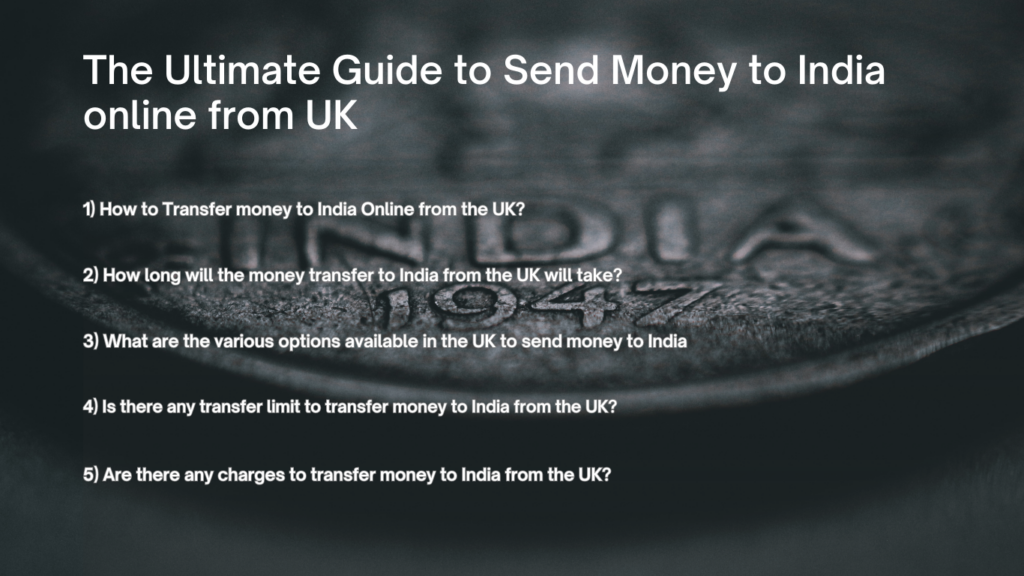International Money Transfers from the UK to India have never been easier than it is today. This Guide sheds light on the world of finance and currency exchange. Imagine you have been working in London or some other states of the UK for years, and suddenly you realize that your funds can be sent to your family in India from the UK hassle-free. So let’s discover how you can send your remittance to India without paying any additional charges/fees while gaining a favorable exchange rate for your INR.
By the end of this Guide you will gain an idea of the following:

1) How to Transfer money to India Online from the UK?
Remittance services, also known as online money transfers, are becoming a popular way to send money across countries. Millions of people worldwide have used these services, especially those who need to transfer money from one location to another, such as from the UK to India. Remitting money to India not only benefits the individuals and their families who receive it, but it also helps stimulate India’s economy. With online money transfers, you can easily keep track of your transactions and ensure the security of your finances.
Compared to traditional methods of transferring money abroad, online money transfer is more practical, secure, and affordable. This method allows you to send money in real-time without the need to visit physical locations or wait for a long time for the transaction to be completed. Additionally, it provides a simple way to keep track of your transactions and progress. If you are looking to send money to India from the UK, online money transfers are a convenient and reliable option to consider. Here are few tips to get Best Exchange Rate.
2) How long will the money transfer to India from the UK will take?
Many factors can affect the speed of the transaction, including the transfer method, the amount being transferred, and the time of day the transfer is initiated. However, in general, it typically takes one to two business days for the money to be transferred successfully.
Several factors can influence the speed of the transfer. One of the most significant is the transfer method chosen. Bank transfers, for example, can take longer than digital money transfer services due to additional verification and processing requirements. Additionally, the amount being transferred can also affect the processing time, with larger sums often taking longer to process due to additional security checks.
The time of day the transfer is initiated can also play a role in the processing time. For example, transfers initiated outside of regular business hours or during weekends may take longer to complete, as banks and money transfer services may have reduced staffing during these times.
Despite these potential factors, it typically takes one to two business days for the money transfer to be completed successfully in digital way. This time frame allows for any necessary verifications or security checks to be conducted, while still ensuring that the funds are transferred in a timely manner.
It’s important to note that the speed of the transfer may also depend on the specific money transfer service being used. While many services offer different transfer times, it’s always a good idea to research and compare different options to find the one that best fits your needs.
3) What are the various options available in the UK to send money to India
This article is based on helping our audience with money transfer through digital means. However, we would also like to share some of the basics of the knowledge gathered to make a comparison between what it is like to send through different means. Thus, to make aware of if any of the options feels like it is the right fit for you.
- Bank transfers: This is one of the most traditional methods of sending money to India. You can transfer funds from your bank account in the UK to an account in India. However, this method can be slower and more expensive than other options.
- Money transfer operators: There are several money transfer operators available that specialize in transferring money across borders. Examples include Western Union, MoneyGram, and Ria Money Transfer. These operators offer quick and easy transfers, but they can be more expensive than other options due to fees and exchange rate markups.
- Online remittance services: These services allow you to transfer money online from your UK bank account to an account in India. Examples include Xmonies , TransferWise, Remitly, and Xoom. These services are often faster and cheaper than bank transfers or money transfer operators. As they charge few to no fees on the transfer while giving you competitive forex rates.
- International wire transfer: International wire transfer is a direct method of transferring funds from your UK bank account to an Indian bank account. This method can be expensive and may take several days to process, but it’s a secure way of transferring large amounts of money.
- Foreign exchange brokers: Foreign exchange brokers specialize in currency exchange and can offer competitive rates for currency transfers. This method may be more suitable for larger amounts of money, but it’s important to research the broker’s reputation and fees.
- Prepaid debit cards: Prepaid debit cards such as the State Bank of India (SBI) Global debit card can be used to withdraw cash from ATMs in India. These cards can be loaded with money from your UK bank account and can be a convenient option for those who frequently travel to India.
- Direct cash deposits: Some money transfer operators such as Western Union and MoneyGram offer direct cash deposits to Indian bank accounts. This method can be fast and convenient, but it can be expensive and may not be suitable for large transfers.
4) Is there any transfer limit to transfer money to India from the UK?
As for Xmonies, a digital remittance service, they may have their own transfer limits, which can vary depending on the destination country, the recipient’s bank, and other factors. According to their website, Xmonies allows customers to send up to £100,000 per transaction to India from the UK.
However, it’s important to note that sending large amounts of money may require additional documentation or checks to comply with regulatory requirements, such as anti-money laundering laws. Therefore, it’s always a good idea to check with the service provider and ensure that you have all the necessary documentation and information before sending a large sum of money.
The maximum amount of money that may be transmitted may be governed by the bank or money transfer service you are using. Moreover, certain transactions can be subject to regulatory limitations like anti-money laundering rules, which might call for further inspections.
It is important to verify with your preferred service provider or bank to learn more details on how much money you may transfer to India from the UK. They need to be able to provide you with precise details about any transfer restrictions or caps that could be in place.
5) Are there any charges to transfer money to India from the UK?
The charges to send money to India from the UK can vary depending on the method of transfer and the service you choose. Banks and other financial institutions may charge a fee for international money transfers, which can vary depending on the amount being transferred and the speed of the transfer. Additionally, exchange rates can also impact on the total cost of the transfer.
When sending money to India, it’s also important to consider any taxes or regulatory fees that may apply. Some transactions may be subject to taxes or other fees in the UK or in India, which can impact the total cost of the transfer. Overall, it’s important to do your research and compare options carefully to ensure you are getting the best value for your money when sending funds to India from the UK.
XMonies, which is a digital remittance service, does not charge any additional fees on the transfer of money from the UK to India. This means that the cost of the transfer is based solely on the exchange rate and any applicable taxes or regulatory fees, which can be an advantage for customers looking to save money on international money transfers.
Conclusion:
It’s always a good idea to compare different service providers and their fees and exchange rates to ensure you are getting the best value for your money. However, with XMonies, customers can benefit from no additional remittance fees, and easy transfer which can make sending money to India from the UK more affordable and convenient.






